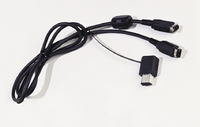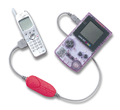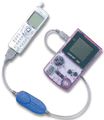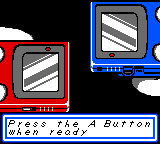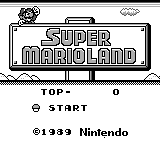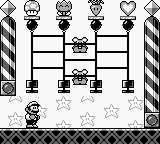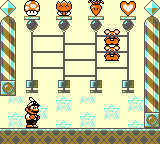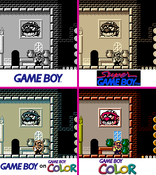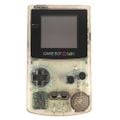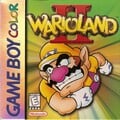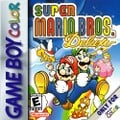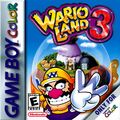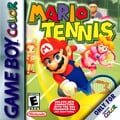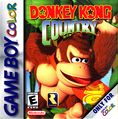Game Boy Color
- This article is about the handheld gaming system. For the gamebook series that originally used the name "Game Boy Color", see Game Boy Advance (book series).
- "GBC" redirects here. For the accessory for the Game Boy systems, see Game Boy Camera.
| Game Boy Color | |
|---|---|
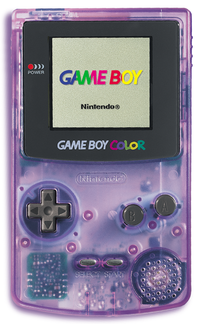 An atomic purple Game Boy Color model | |
| Generation | Fifth generation |
| Release date | |
| Discontinued | |
| Predecessor | Game Boy Virtual Boy |
| Successor | Game Boy Advance |
- “Get into it.”
- —The Game Boy Color slogan
The Game Boy Color (also abbreviated as GBC) is the fourth model to the Game Boy and, in some ways, the handheld counterpart of the Nintendo 64. It is similar to its predecessors, the most notable differences being that it is lighter, it is capable of displaying multiple colors, and the processing power is twice as fast. It is the final 8-bit handheld console. Although it is popularly described as a successor to the Game Boy due to its hardware advancements and the existence of Game Boy Color games that are incompatible with a standard Game Boy, Nintendo internally categorized it as a hardware revision. This disparity is reflected in the company's public representation of the system, such as in Super Smash Bros. Brawl, where the Chronicle lists Game Boy and Game Boy Color games under one section.
Some games made for the original Game Boy display more colors if played on a Game Boy Color. Other games were made exclusively for the Game Boy Color. The older versions could not play these, but the Game Boy Advance, the Game Boy Advance SP, and the Game Boy Player could. It also had the shortest lifetime of a Nintendo handheld, as it was discontinued in 2003, and the last game was released later the same year.
The Game Boy Color has identical controls to those of the original Game Boy and the NES controller. These are ,
,
, and
buttons and the
. There are no compatibility issues with games made for the original Game Boy being run on a Game Boy Color. All games, accessories that are programmed for a particular game (such as a Game Link Cable), and non-standard features (such as the camera protruding out of a Game Boy Camera cartridge) will work on a Game Boy Color. Playing games that did not have any color can now be played in color using a color palette by using a combination of
and
,
, or no additional button being pressed to select presets, similar to the Super Game Boy how someone can change the colors into the typical monochrome display.
A device known as the Game Boy Horror, modeled after the Game Boy Color, appears in Luigi's Mansion.
Some Game Boy and Game Boy Color games were once available through the Nintendo 3DS Virtual Console service until the Nintendo 3DS eShop's closure on March 27, 2023.
Hardware specifications
- CPU: Sharp SM83 (custom Intel 8080/Zilog Z80 hybrid, 8-bit) @ 4.194304 or 8.388608 MHz
- Memory: 32 KB Work RAM, 16 KB Video RAM, 2 KB "Bootstrap" ROM, 1.12KB object attribute RAM, 128 B Audio RAM, 127 B High RAM[2]
- Resolution: 160x144 pixels (Same as Game Boy)
- Colors: 32,768 (15-bit RGB)
- Maximum number of colors on screen: 56
- Maximum sprite size: 8x16 or 16x8 pixels
- Maximum number of sprites on screen: 40 sprites, 10 per scanline (Same as Game Boy)
- Maximum number of colors on sprite: 4 (Same as Family Computer / NES)[3][4]
- Minimum/Maximum cartridge size: 32 KB / 8 MB[5]
- Sound: 4 channels
Compatibility modes
All older cartridges are compatible with the Game Boy Color but not always the other way around. Here is a chart to explain.
| Example cartridge | Usual color | Game Boy mode | Super Game Boy mode | Game Boy Color mode | |
|---|---|---|---|---|---|
| Original Game Boy cartridge | 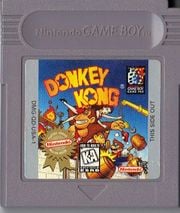
|
Gray | Varies | ||
| Game Boy Color cartridge | 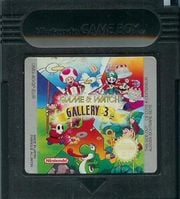
|
Black | Varies | ||
| Game Boy Color cartridge | 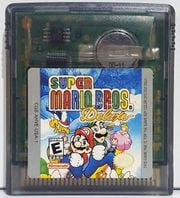
|
Clear |
Accessories
This section is a stub. Please consider expanding it to include any missing information. Specifics: Add more information and their relevance to Super Mario
All official accessories compatible with the Game Boy are compatible with the Game Boy Color.
Game Link Cable
The same link cable the Game Boy and its variations use can be used on Game Boy Color.
Game Boy Printer
The Game Boy Printer that was used to print pictures from the player's Game Boy. This accessory gained some extended support when the Game Boy Color was released, such as being used in Super Mario Bros. Deluxe in Toy Box image albums and in Records tables, in Donkey Kong Country for the DK Sticker Packs, and as an accessory for Game Boy Camera.
Mobile Adapter GB
Only available in Japan, the Mobile Adapter GB allowed certain games to connect to some Japanese mobile phones. The only strictly Super Mario games to utilize it were Mobile Golf and Mario Kart: Super Circuit; however, the operation software that came with it (Mobile Trainer) features references to the Super Mario franchise. This peripheral was referred to as the Mobile Game Boy Adapter in a translated Iwata Asks interview. The device was released exclusively to Japan on January 27, 2001 and was not a commercial success.
A part of the service was the Mobile System GB, which allowed players to log on to the internet to access a network for wireless play across the nation via Nintendo servers. Using this server, Mobile Golf could be played online wirelessly, a precursor to the Nintendo Wi-Fi Connection and Nintendo Network. Just as the device was not successful, the Mobile System GB was not successful and closed down on December 14, 2002.
IR communication
There is an infrared LED, indicated by the black rectangle on top of the unit, that a Game Boy Color can use. This was the primary method in which Mystery Gift worked in the Generation II Pokémon games, but Super Mario Bros. Deluxe can make use of this feature by sending high scores and other data to other copies. This feature is exclusive to the Game Boy Color and is not present in later Game Boy devices.
BIOS colors
These colors will also work on a Game Boy Advance, a Game Boy Advance SP and a Game Boy Player when a Game Boy game is inserted, but will not work on Virtual Console on Nintendo 3DS, whereas in Game Boy - Nintendo Switch Online only the hardware-coded palette for each game can be set as a color palette.
| No input | 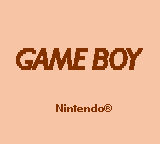 Brown |
 Pale Yellow[6]/Pastel Mix[7] |
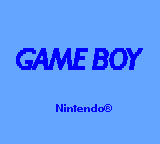 Blue |
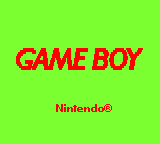 Green |
|---|---|---|---|---|
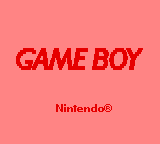 Red |
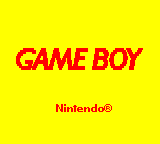 Orange |
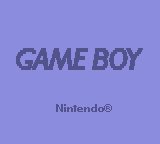 Dark Blue |
 Dark Green | |
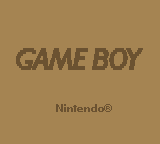 Dark Brown |
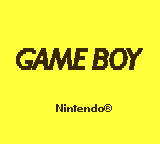 Yellow |
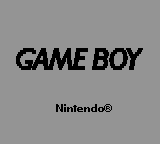 Original Gray |
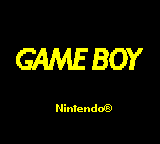 Reverse |
It has been requested that more images be uploaded for this article. Remove this notice only after the additional images have been added. Specifics: Super Mario Land and Super Mario Land 2: 6 Golden Coins are not the only games to have this functionality
The Game Boy Color will display a unique hardware-coded palette of colors for some titles using an internal list of original Game Boy games. Two such instances are Super Mario Land and Super Mario Land 2: 6 Golden Coins. The palettes do however fall short of being a full colorization of the games, notably in the case of Dr. Mario where the regular black and square-patterned black viruses look similar.
Comparison for the Game Boy version of Dr. Mario
Comparison for the Game Boy and native Game Boy Color versions of Wario Land II
Comparison for Donkey Kong
Official in-app comparison for Super Mario Land 2: 6 Golden Coins in Game Boy - Nintendo Switch Online
Super Mario games
1998
1999
2000
2001
Galleries
System gallery
Standard colors
Special editions
Game gallery
Miscellaneous
A promotional image of the variety of colors of Game Boy Color handhelds and various Game Boy Color games in the Fox Kids Wario Land 3 poll
Names in other languages
| Language | Name | Meaning | Notes |
|---|---|---|---|
| Japanese | ゲームボーイカラー[8] Gēmu Bōi Karā |
Game Boy Color |
Notes
- The Game Boy Color, the Nintendo GameCube, and the Wii U were all released on the same day of their respective years in the Americas.
- This is Nintendo of Australia's first portable console.
- Each letter from the word "COLOR" in the logo is displayed in one of the system's five launch colors.
- In Commonwealth English, the correct spelling for "color" is "colour". Despite this, the name of the console was never changed outside of America to reflect this difference.
References
- ^ 신상민 (January 4, 2001). 정식유통판 게임보이 컬러, 호응누린다. GameMeca (Korean). Retrieved June 9, 2024. (Archived June 22, 2022, 15:37:38 UTC via Wayback Machine.)
- ^ December 3, 1999. Game Boy Programming Manual. Nintendo. Page 12-16.
- ^ http://nesdev.com/NESTechFAQ.htm#chrgfx
- ^ http://www.consoledatabase.com/consoleinfo/nintendogameboycolor/
- ^ http://www.chrisantonellis.com/files/gameboy/gb-programming-manual.pdf
- ^ GBC Manual
- ^ GBA Manual
- ^ ハードウエアの紹介. Nintendo Co., Ltd. (Japanese). Retrieved January 22, 2025.
| show Game Boy Color games |
|---|
| show Video game systems and add-ons |
|---|

